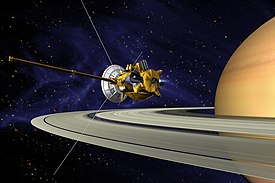Cassini orbiter

Artist's concept of Cassini's orbit insertion around Saturn
|
|
| Mission type |
Cassini: Saturn orbiter Huygens: Titan lander |
|---|---|
| Operator |
Cassini: NASA / JPL Huygens: ESA / ASI |
| COSPAR ID | 1997-061A |
| SATCAT no. | 25008 |
| Website | |
| Mission duration |
|
| Spacecraft properties | |
| Manufacturer |
Cassini: Jet Propulsion Laboratory Huygens: Alcatel Alenia Space |
| Launch mass | 5,712 kg (12,593 lb) |
| Dry mass | 2,523 kg (5,562 lb) |
| Power | ~880 watts (BOL) ~670 watts (2010) |
| Start of mission | |
| Launch date | October 15, 1997, 08:43:00 UTC |
| Rocket | Titan IV(401)B B-33 |
| Launch site | Cape Canaveral SLC-40 |
| Orbital parameters | |
| Reference system | Kronocentric |
| Flyby of Venus (Gravity assist) | |
| Closest approach | April 26, 1998 |
| Distance | 283 km (176 mi) |
| Flyby of Venus (Gravity assist) | |
| Closest approach | June 24, 1999 |
| Distance | 6,052 km (3,761 mi) |
| Flyby of Earth-Moon system (Gravity assist) | |
| Closest approach | August 18, 1999, 03:28 UTC |
| Distance | 1,171 km (728 mi) |
| Flyby of 2685 Masursky (Incidental) | |
| Closest approach | January 23, 2000 |
| Distance | 1,600,000 km (990,000 mi) |
| Flyby of Jupiter (Gravity assist) | |
| Closest approach | December 30, 2000 |
| Distance | 9,852,924 km (6,122,323 mi) |
| Saturn orbiter | |
| Orbital insertion | July 1, 2004, 02:48 UTC |
| Titan lander | |
| Spacecraft component | Huygens |
| Landing date | January 14, 2005 |
|
|
|
|
© ESA/NASA/JPL/U. of Arizona. (ESA hosting) |
Cassini–Huygens is an unmanned spacecraft sent to the planet Saturn. It is a Flagship-class NASA–ESA–ASI robotic spacecraft.Cassini is the fourth space probe to visit Saturn and the first to enter orbit, and its mission is ongoing as of April 2017[update]. It has studied the planet and its many natural satellites since arriving there in 2004.
Development started in the 1980s. Its design includes a Saturn orbiter (Cassini) and a lander (Huygens) for the moon Titan. The two spacecraft are named after astronomers Giovanni Cassini and Christiaan Huygens. The spacecraft launched on October 15, 1997 aboard a Titan IVB/Centaur and entered orbit around Saturn on July 1, 2004, after an interplanetary voyage that included flybys of Earth, Venus, and Jupiter. On December 25, 2004, Huygens separated from the orbiter, and it landed on Saturn's moon Titan on January 14, 2005. It successfully returned data to Earth, using the orbiter as a relay. This was the first landing ever accomplished in the outer Solar System.
Cassini continued to study the Saturn system in the following years, and continues to operate as of April 2017. However, since November 30, 2016, due to the spacecraft's dwindling fuel resources for further orbital corrections, Cassini entered the final phase of the project. Cassini will dive through the outer ring of Saturn 20 times, once every seven days. The spacecraft will enter areas that have been untouched up until this point, getting the closest look ever at Saturn's outer rings. The first pass of the rings took place on December 4, 2016.
...
Wikipedia
